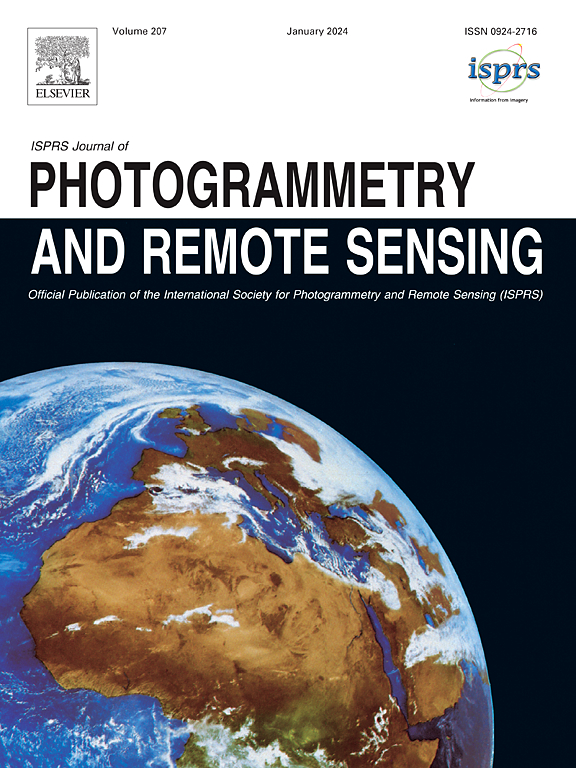多幅图像中三维线条的聚类、三角测量和评估
IF 10.6
1区 地球科学
Q1 GEOGRAPHY, PHYSICAL
ISPRS Journal of Photogrammetry and Remote Sensing
Pub Date : 2024-10-08
DOI:10.1016/j.isprsjprs.2024.10.001
引用次数: 0
摘要
三维(3D)线条需要在聚类和三角测量方面进一步改进。线条聚类将多条图像线条分配给一条三维线条,以消除多余的三维线条。目前,它取决于固定的经验参数。然而,松散的参数可能导致过度聚类,而严格的参数则可能造成冗余三维线。由于缺乏地面实况,对线条聚类的评估仍有待探索。此外,三维线三角测量确定了物体空间中的三维线段,但由于其对位置误差和相机误差的敏感性而容易失败。(1) 为了实现精确聚类,我们引入了一个概率模型,利用运动结构的先验误差来确定自适应阈值,从而控制由固定超参数引起的错误聚类。(2) 为了实现稳健的三角测量,我们采用了一个通用框架,通过各种形式的几何一致性来完善三维线。(3) 为了进行可靠的评估,我们调查了城市环境中的一致模式,以评估聚类和三角测量,从而消除了手动绘制地面实况的需要。为了评估我们的方法,我们使用了互联网图像数据集,总计超过 1 万张图像,以及尺寸超过 1 万像素的航空图像。我们将我们的方法与最先进的方法进行了比较,包括 Line3D++、Limap 和 ELSR。在这些数据集中,我们的方法在聚类和三角测量精度方面分别提高了至少 20% 和 3%。此外,我们的方法在执行速度上排名第二,仅次于目前最快的算法 ELSR。本文中使用的数据集和算法的 C++ 源代码可在 https://github.com/weidong-whu/3DLineResconstruction 上获取。本文章由计算机程序翻译,如有差异,请以英文原文为准。
Clustering, triangulation, and evaluation of 3D lines in multiple images
Three-dimensional (3D) lines require further enhancement in both clustering and triangulation. Line clustering assigns multiple image lines to a single 3D line to eliminate redundant 3D lines. Currently, it depends on the fixed and empirical parameter. However, a loose parameter could lead to over-clustering, while a strict one may cause redundant 3D lines. Due to the absence of the ground truth, the assessment of line clustering remains unexplored. Additionally, 3D line triangulation, which determines the 3D line segment in object space, is prone to failure due to its sensitivity to positional and camera errors.
This paper aims to improve the clustering and triangulation of 3D lines and to offer a reliable evaluation method. (1) To achieve accurate clustering, we introduce a probability model, which uses the prior error of the structure from the motion, to determine adaptive thresholds; thus controlling false clustering caused by the fixed hyperparameter. (2) For robust triangulation, we employ a universal framework that refines the 3D line with various forms of geometric consistency. (3) For a reliable evaluation, we investigate consistent patterns in urban environments to evaluate the clustering and triangulation, eliminating the need to manually draw the ground truth.
To evaluate our method, we utilized datasets of Internet image, totaling over ten thousand images, alongside aerial images with dimensions exceeding ten thousand pixels. We compared our approach to state-of-the-art methods, including Line3D++, Limap, and ELSR. In these datasets, our method demonstrated improvements in clustering and triangulation accuracy by at least 20% and 3%, respectively. Additionally, our method ranked second in execution speed, surpassed only by ELSR, the current fastest algorithm. The C++ source code for the proposed algorithm, along with the dataset used in this paper, is available at https://github.com/weidong-whu/3DLineResconstruction.
求助全文
通过发布文献求助,成功后即可免费获取论文全文。
去求助
来源期刊

ISPRS Journal of Photogrammetry and Remote Sensing
工程技术-成像科学与照相技术
CiteScore
21.00
自引率
6.30%
发文量
273
审稿时长
40 days
期刊介绍:
The ISPRS Journal of Photogrammetry and Remote Sensing (P&RS) serves as the official journal of the International Society for Photogrammetry and Remote Sensing (ISPRS). It acts as a platform for scientists and professionals worldwide who are involved in various disciplines that utilize photogrammetry, remote sensing, spatial information systems, computer vision, and related fields. The journal aims to facilitate communication and dissemination of advancements in these disciplines, while also acting as a comprehensive source of reference and archive.
P&RS endeavors to publish high-quality, peer-reviewed research papers that are preferably original and have not been published before. These papers can cover scientific/research, technological development, or application/practical aspects. Additionally, the journal welcomes papers that are based on presentations from ISPRS meetings, as long as they are considered significant contributions to the aforementioned fields.
In particular, P&RS encourages the submission of papers that are of broad scientific interest, showcase innovative applications (especially in emerging fields), have an interdisciplinary focus, discuss topics that have received limited attention in P&RS or related journals, or explore new directions in scientific or professional realms. It is preferred that theoretical papers include practical applications, while papers focusing on systems and applications should include a theoretical background.
 求助内容:
求助内容: 应助结果提醒方式:
应助结果提醒方式:


